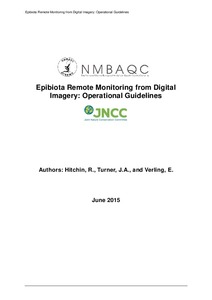Epibiota Remote Monitoring from Digital Imagery: Operational Guidelines.

View/
Average rating
votes
Date
2015Author
Hitchin, R.
Turner, J.A.
Verling, E.
Status
PublishedPages
24pp.
Metadata
Show full item recordAbstract
There is increasing recognition that the effective acquisition and interpretation of underwater
video and still image data for biodiversity is growing in importance. Numerous organisations
(e.g. Statutory Nature Conservation Bodies (SNCBs), Inshore Fisheries Conservation
Authorities (IFCAs), environmental consultancy agencies, industry and academic institutes)
are now engaged in this work for a variety of different purposes, including:
Marine habitat mapping of physical seabed habitats and features in support of a
variety of national and international initiatives, e.g. the Marine Environmental Mapping
Programme (MAREMAP), Integrated Mapping For the Sustainable Development of
Ireland's Marine Resource (INFOMAR) and Mapping European Seabed Habitats
(MESH).
Characterisation of epifaunal attributes of seabed habitats and features e.g. in
support of the Marine Strategy Framework Directive, Water Framework Directive,
designation of Marine Protected Areas (European and Nationa.....
Publisher
Joint Nature Conservation Committee (JNCC)/ NMBAQCSPeterborough, UK
Document Language
enSustainable Development Goals (SDG)
14.AEssential Ocean Variables (EOV)
Benthic invertebrate abundance and distributionBest Practice Type
Best PracticeGuide
Citation
Hitchin, R., Turner, J.A. and Verling, E. (2015) Epibiota remote monitoring from digital imagery: Operational guidelines. Peterborough, UK, JNCC/NMBAQCS, 24pp. DOI: 10.25607/OBP-413Collections
 Repository of community practices in Ocean Research, Applications and Data/Information Management
Repository of community practices in Ocean Research, Applications and Data/Information Management